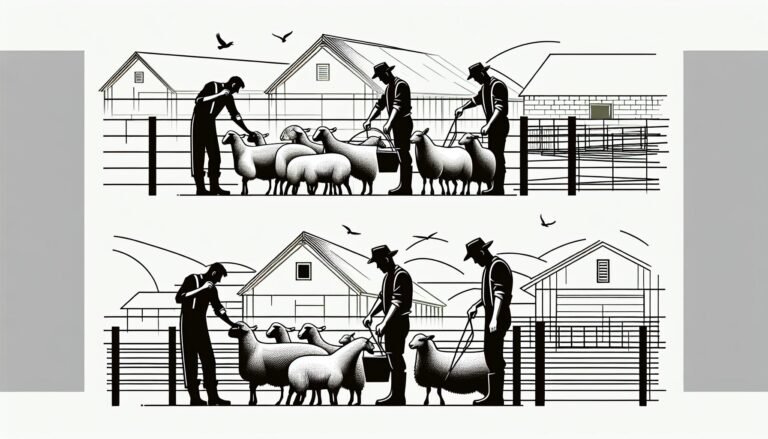Unlocking Efficiency in Sheep Farming: The Importance of Drafting Sheep
Ever wondered why farmers draft their sheep? It’s a question that’s puzzled many, but as an experienced blogger, I’m here to shed some light on it. Drafting sheep, also known as sorting, is an integral part of sheep farming, and it’s about more than just separating the flock.
In the world of sheep farming, drafting is an art that requires skill and precision. It’s not just about dividing sheep into different groups, but also about ensuring the health and productivity of the flock. Stick with me as I delve into the reasons behind this fascinating practice.
Key Takeaways
- Drafting, or sorting, is a central part of efficient sheep farming. It allows the farmer to separate and group sheep based on various factors such as age, sex, weight, and breeding status, which leads to effective flock management.
- The practice of drafting enhances the prevention of disease spread within the flock. By separating young and old sheep or ill and healthy ones, one can contain potential illnesses and provide better care.
- Drafting aids in breeding management. It helps control breeding cycles, ensures optimal lambing times, and facilitates better management during birthing periods, which results in a more productive flock.
- The practice ensures flock’s productivity by isolating high-performing sheep, encouraging a competitive environment that benefits the whole flock.
- Drafting is vital for identifying and managing health issues in the flock. Weight changes detected during drafting can hint towards potential health problems, allowing swift action.
- Strategic sorting or drafting optimizes resource distribution and simplifies management procedures, promoting flock wellbeing while maximizing productivity.
- Each sheep farm might have unique parameters for drafting based on the farmer’s specific goals and the farm’s unique landscape and climate conditions.
The Purpose of Drafting Sheep
As we delve into this essential practice, let’s take a moment to understand the why behind drafting sheep. It’s certainly no arbitrary task. In fact, drafting lies at the core of efficient flocks management, having me, the farmer, in the driver’s seat of my flock’s health, productivity, and overall wellbeing.
Primarily, drafting ensures optimal flock control. It’s all about grouping and separating sheep based on numerous parameters such as age, sex, weight, and breeding status. Like building different teams in a sports tournament, each group serves a unique purpose.
Groups defined by age are beneficial for preventing disease spread. Young sheep often susceptible to ailments elderly ones resist can be safely separated, thereby averting disastrous outbreaks within the flock.
Drafting also proves vital in breeding management. By segregating rams and ewes, I can better control the breeding cycle, ensuring that lambs are born at optimal times. Moreover, this allows me to group ewes with similar lambing schedules together, facilitating more effective management and observation during birthing periods.
On the productivity front, drafting enables me to isolate high-performing animals from the rest, directly influencing the flock’s profitability. Imagine a school system where the top performers are grouped together – it encourages competition, accelerates enhancement, and ultimately ups the performance ante for the entire flock!
Lastly, the health aspect can’t be ignored. Drafting allows swift separation of unwell or injured animals, preventing illnesses from spreading and ensuring that those in need receive adequate care promptly. It’s akin to quarantining humans during a pandemic – isolation is key to containment.
As we can see, the purposes of drafting are clear. It assists me in segregating my sheep based on their unique needs and characteristics, ensuring efficient management, optimized productivity, and robust flock health. It’s not just about separating the sheep – it’s about strategically controlling my flock to yield the best results across the board.
Join me in the following section as we look at some real-life application examples of drafting in sheep farming. It’ll provide a practical perspective on why this age-old practice continues to remain so crucial in modern sheep husbandry.
Please note that each sheep farm may have its unique parameters for drafting, based on the farmer’s specific goals and the farm’s unique landscape and climate conditions.
Improving Efficiency in Sheep Farming
Drafting sheep is a fundamental part of running an efficient sheep farming operation. Hand-in-hand with good management practices, it greatly contributes to a farm’s overall performance. Unlike traditional methods, where farmers visually assess their flock, drafting is precise. It’s based on quantifiable parameters which ensure accuracy.
Drafting has a multifaceted role – it’s used for grouping and separating sheep but also serves as an operational tool to maintain the flock’s overall well-being and health. Ailing animals are quickly identified and separated through drafting, which results in a more productive flock. Utilization of drafting also allows better control of the flock’s growth, weight gain, and reproduction, leading to strategic improvements in productivity. Moreover, drafting ensures that your flock has homogeneity which can significantly improve the quality of the end product, be it wool, milk, or meat.
The practice of drafting can have a profound effect on a farm’s efficiency. Its implementation can create a direct impact on productivity, profits, and overall outcomes. By segregating sheep based on age, sex, weight, and breeding status, farmers can now ensure the best conditions for all animals. For instance, pregnant ewes would have specific nutritional requirements which can be met more effectively when they are grouped separately.
The table below further underscores the beneficial impact of drafting on flock productivity and health.
| Parameters | Without Drafting | With Drafting |
|---|---|---|
| Disease Control | Difficult | Easier |
| Nutrition Management | Vague | Precise |
| Breeding Management | Complex | Simplified |
| Flock Growth | Random | Controlled |
It’s important to note that each farm will have unique parameters for drafting. The characteristics of the geographic location, climate conditions and the specific goals of the farmer will greatly influence the drafting rules adopted.
By strategically grouping and managing your flock based on specific parameters, not only can you optimize the productivity, you can ensure the robust health of your sheep. This isn’t just beneficial for the animals but also for the end-consumer. It should be no surprise, therefore, that drafting has gained wide acceptance in the farming community, being considered an indispensable tool for improving farm efficiency.
Identifying and Managing Health Issues
Drafting plays a paramount role in identifying and managing health issues in a sheep flock. When we’re dealing with large numbers of livestock, disease control becomes a critical aspect of a successful farming operation. It’s here that the precision and objective nature of drafting come into play.
One of the key benefits of drafting is rapidly locating and segregating sick or injured sheep. Changes in a sheep’s weight can often hint towards health issues that might be brewing under the surface. When drafting based on weight, it’s easier to pinpoint these issues before they escalate into larger problems. This swift identification and separation of unwell animals not only safeguards the individual animal’s health, but it also helps protect the rest of the flock from potential exposure and spread of diseases.
It’s also worth noting that segregating sheep based on age or sex can lessen stress, particularly for younger or weaker animals. Less stress translates to better immune systems and overall stronger health.
Breeding management too gets streamlined by effective drafting. Breeding and pregnancy in sheep can pose health risks, particularly in cases where the sheep is too young or old. By grouping and separating sheep based on breeding status, farmers can closely monitor and manage the health of breeding stock and pregnant ewes.
The dimensions of health management have a broader scope with drafting in the picture. It’s not just about isolating and treating sick sheep, but also about implementing proactive strategies to optimize nutritional management, reduce stress, enhance breeding control, and ultimately enrich overall flock well-being. Each sheep drafting parameter plays its part in the puzzle of health management, and the mosaic that emerges proves the effectiveness of drafting in farm efficiency and robust sheep health.
Maximizing Productivity through Strategic Sorting
In the sheep farming industry, every second counts and efficiency is king. That’s where drafting, or strategic sorting, comes into play. It’s a clever tool used to streamline processes and maximize productivity. But how exactly does it work? Allow me, an experienced blogger in this field, to break it down.
Through the drafting process, I’m able to create specific groups within my flock, selecting sheep based on various criteria like age, sex, weight, and breeding status. This grouping mechanism is far from arbitrary – it is an essential component for heightened productivity.
By grouping similar sheep together, a farmer can optimize the delivery of resources. It’s easier, for example, to balance the nutritional needs of a group of sheep that are similar in age or size, rather than trying to cater to a mixed group with diverse needs. Likewise, separating breeding stock allows me to focus my attention and resources on those sheep, without neglecting the rest of the flock. After all, targeted and timely care promotes healthy growth and breeding success.
While productivity is an important aspect, strategic sorting is equally crucial for health management. Drafting mitigates the spread of diseases, providing a safety buffer for the rest of the flock. Let’s say one sheep falls ill, by quickly identifying and isolating that individual, I lower the risk of exposing healthy animals. It’s a simple step that can save a flock from a devastating health crisis.
When it comes to lambing, drafting also proves invaluable. It’s easier to monitor newborn lambs and their mothers when they’re gathered in a separate area. The expectant ewes enjoy a stress-free environment, while the lambs gain protection from possible predators or aggressive flock members. It’s a win-win situation.
So, whether it’s about enhancing health management, improving resource allocation, simplifying breeding procedures, or protecting young lambs, drafting gives us the power to amplify productivity without compromising on flock well-being.
Conclusion
So there you have it. Drafting sheep isn’t just a random practice – it’s a strategic move that boosts efficiency and safeguards flock health. By grouping sheep based on specific parameters, farmers can streamline resource allocation and simplify breeding processes. It’s also an effective way to keep diseases at bay and create a less stressful environment for younger or weaker animals. The benefits are clear: better health management, optimized resources, and enhanced productivity. It’s no wonder that drafting is a common practice in sheep farming. I hope that this understanding of the ‘why’ behind sheep drafting can lead to more effective and humane farming practices.







